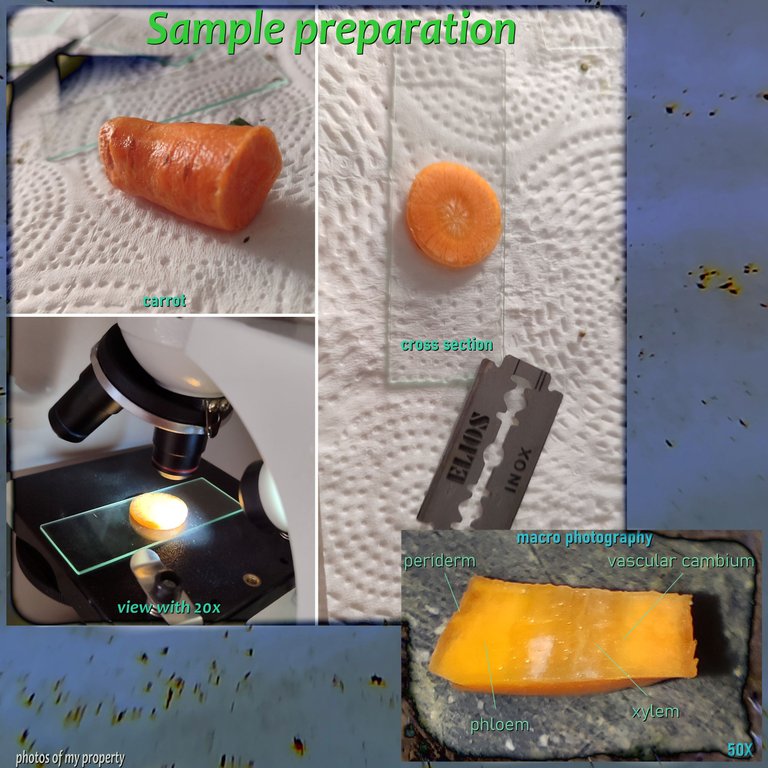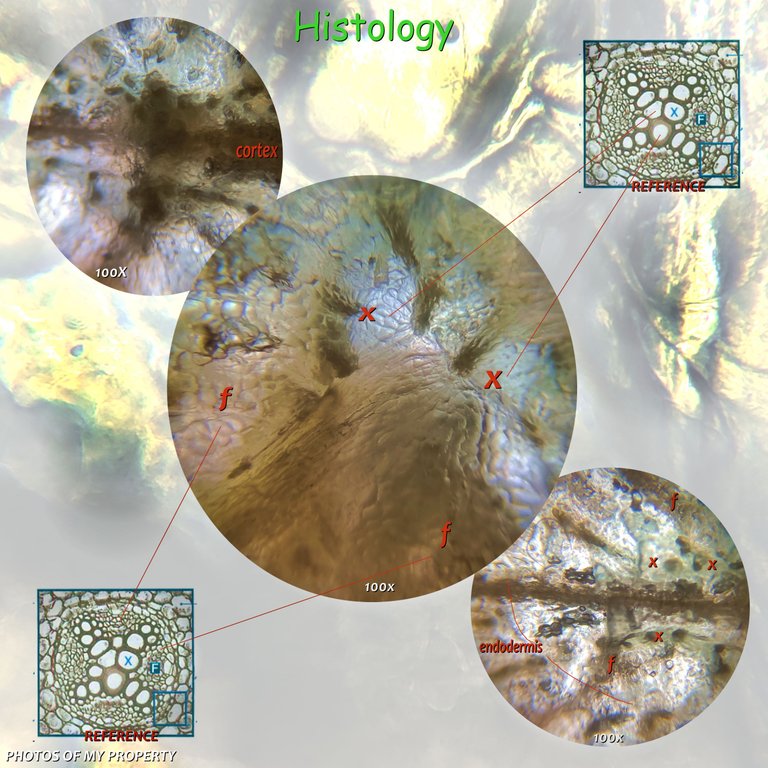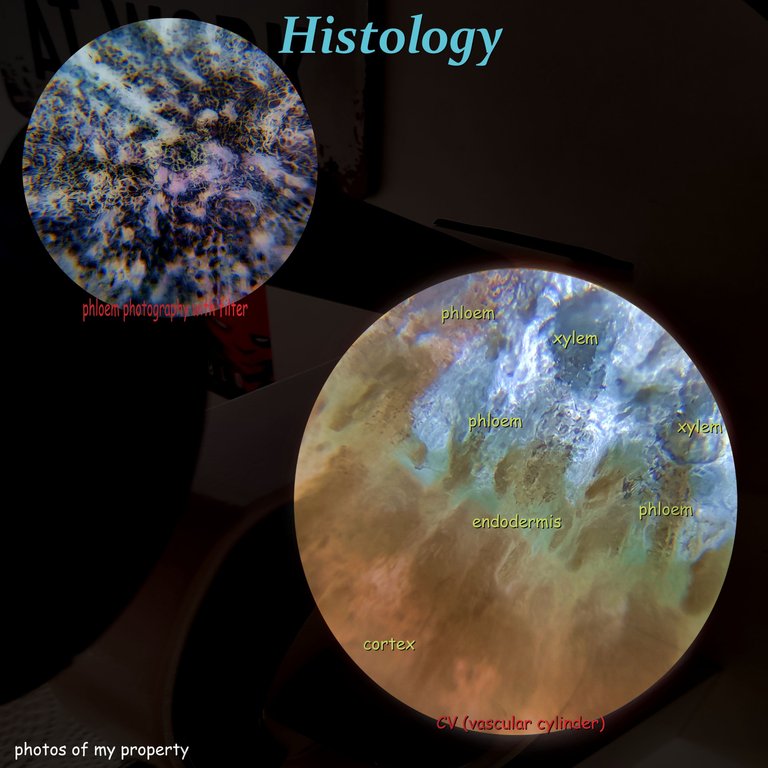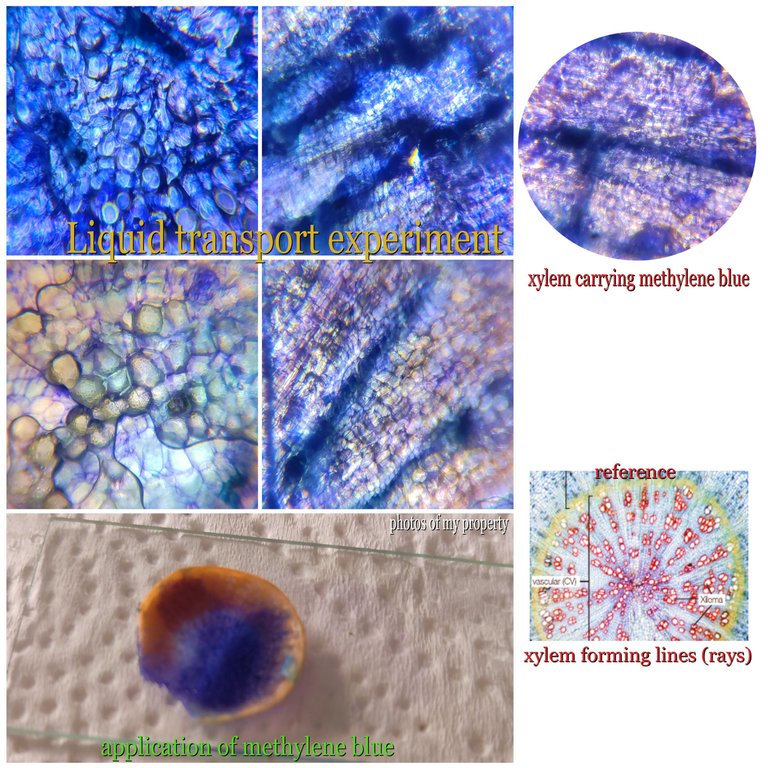Hello friends who love science, today I bring you a very interesting post and we are going to see a carrot under a microscope for the first time and with this we will make a very scientific post since we will be able to identify the tissue (xylem-phloem), what do you think the carrot is? a fruit? root? stem? if you don't know the answer I will also explain it to you today, therefore it is time to learn botany with a microscope, we will use references from scientific works to explain each tissue and have a deeper focus.🧪🔬
Hola amigos amantes de la ciencia, hoy les traigo un post bastante interesante y vamos a ver por primera vez una zanahoria bajo el microscopio y con esto haremos un post bastante cientifico ya que lograremos identificar el tejido (xilema-floema), que crees que es la zanahoria? una fruta? raiz? tallo?, si no sabes la respuesta tambien te la explicare hoy por tanto es hora de aprender botanica con el microscopio, utilizaremos referencias de trabajos cientificos para explicar cada tejido y tener un enfoque mas profundo.🤓🧑🏻🎓

The carrot is a root🤓🔬 /La zanahoria es una raiz🥕🧫

Okay, let’s answer the first question, is a carrot a stem? A root? If you answered “root,” you’re right. Note that the root is the part of the plant that supports the soil along with the stem, but it also performs a very important function, which is to absorb nutrients from the substrate. Once the substances are absorbed, they are transported throughout the plant by means of transport tissues. Remember when I posted about the stem? We were referring to xylem and phloem? Well, these transport tissues also appear in the root. But did you know that the root also has an advantage in the plant? It acts as a reserve system, mainly for carbohydrates. For this experiment, we’re going to cut a piece of carrot and look at it under a microscope. We’ll use a cross section to help us reveal the parts of the tissue (here we see the peridermis and the vascular cambium, where the xylem and phloem are).
Bien responderemos la primera de las preguntas es la zanahoria un tallo? raiz?, si respondiste raiz estas en lo cierto y fijate que la raiz es la parte de la planta que da soporte con el suelo junto con el tallo pero tambien cumple una funciona bastante importante y es absorber los nutrientes que estan en el sustrato, una vez que se absorben las sustancias son transportadas por toda la planta mediante los tejidos de transporte, recuerdas cuando publique sobre el tallo? que haciamos referencia al xilema y floema? bueno en la raiz tambien aparecen estos tejidos de transporte. Pero sabias que la raiz tambien tiene una ventaja en la planta? actua como sistema de reserva mayoritariamente de carbohidratos. Para este experimento vamos a cortar un pedazo de zanahoria y verlo en el microscopio, usaremos un corte transversal que nos ayudara a revelar las partes del tejido, (aqui vemos la peridermis, y el cambium vascular donde esta el xilema y floema).

Histology of carrot🤓🔬 /Histologia de la zanahoria🥕🧫

The root of the carrot has some "hairs" called "root hairs" which absorb water and other substances such as minerals and introduce them inwards reaching the transport tissues, exactly in the xylem which is in charge of transporting (liquid and minerals), so when we cut a root transversally we will divide it into three parts (rhizodermis which is the same as epidermis), then further inside the (cortex) which is a specialized tissue that prevents the root from losing water or returning to the soil, and finally the vascular tissue (xylem and phloem).🥕🔬
La raiz de la Zanahoria tiene como unos "pelos" llamados "pelos radiculares", las cuales absorben el agua y otras sustancias como minerales y lo introducen hacia adentro llegando a los tejidos de transporte, exactamente en el xilema que es el encargado de transportar (liquido y minerales), asi cuando cortamos una raiz de forma transversal la dividiremos en tres partes (rizodermis que es lo mismo que epidermis), luego mas adentro el (cortex) la cual es un tejido especializado que evita que la raiz pierda agua o que se regrese al suelo, y por ultimo el tejido vascular (xilema y floema).🧑🏻🎓🧪🔬
https://www.innovabiologia.com/biodiversidad/diversidad-vegetal/la-raiz/


The epidermis is the outermost layer of the root and is therefore supposed to be the one that has the most contact with the soil, it has monostratified cells (arranged in a single layer), as they do not have a cuticle they are not impermeable and that causes water to enter here, with the epidermis to follow we have the layer (cortex), it occupies most of the entire root and is mainly composed of parenchymatic tissue, here it can be reserve tissue when it is intended to store the root, (it is common to find carbohydrates such as starch in high concentration here),
La epidermis es la capa mas externa de la raiz y por tanto es supuesta ser la que tiene mas contacto con el suelo, tiene celulas monoestratificadas (dispuesta en una sola capa), como no tienen cuticula no son hipermeable y eso hace que entre agua por aqui, con la epidermis a seguir tenemos la capa (cortex), ocupa la mayor parte de toda la raiz y se compone principalmente por tejido parenquimatico, aqui puede ser tejido de reserva cuando pretende almacenar la raiz, (es comun conseguir carbohidratos como almidon en gran concentracion aqui).
https://www.innovabiologia.com/biodiversidad/diversidad-vegetal/la-raiz/


The epidermis is the outermost layer of the root and therefore is supposed to be the one that has the most contact with the soil, it has monostratified cells (arranged in a single layer), as they have no cuticle they are not hipermeable and that causes water to enter here, next with the epidermis we have the layer (cortex), it occupies most of the entire root and is composed mainly of parenchymatic tissue, here it can be reserve tissue when it tries to store the root, (it is common to find carbohydrates such as starch in high concentration here), following the epidermis we have the important vascular cylinder in the center of the root and here is where we find xylem and phloem, the xylem and phloem in turn form a central "circle" which is called (stele), to form this circle we get the pericycle! In dicotyledonous plants like (Daucus carota) the xylem is arranged in the center of the vascular cylinder in a star shape.🧪🥕
La epidermis es la capa mas externa de la raiz y por tanto es supuesta ser la que tiene mas contacto con el suelo, tiene celulas monoestratificadas (dispuesta en una sola capa), como no tienen cuticula no son hipermeable y eso hace que entre agua por aqui, con la epidermis a seguir tenemos la capa (cortex), ocupa la mayor parte de toda la raiz y se compone principalmente por tejido parenquimatico, aqui puede ser tejido de reserva cuando pretende almacenar la raiz, (es comun conseguir carbohidratos como almidon en gran concentracion aqui), a seguir de la epidermis tenemos el importante cilindro vascular en el centro de la raiz y aqui es donde encontramos xilema y floema, el xilema y floema a su vez forman un "circulo" central el cual se llama (estela), para formar este circulo conseguimos el periciclo! en las plantas dicotiledoneas como (Daucus carota) el xilema se dispone en el centro del cilindro vascular en forma de estrella.🤓🧫
https://www.innovabiologia.com/biodiversidad/diversidad-vegetal/la-raiz/

Experiment to observe transport🤓🔬 /Experimento para observar el transporte🥕🧫


Do you remember I told you that the xylem transports liquid and that it is arranged in the vascular cylinder in the shape of a star? Well we could see this as "rays" surrounding several circles, and in reality if we look at the reference image we see that the xylem are thick lines, so what would happen if we applied a colored transport liquid? Like methylene blue? We would easily see how the liquid is carried by the xylem and would be irrigating from the center to the outside of the root without leaving a space without liquid, incredible right? I also thought about using a filter where the methylene blue would transform it into different colors and differentiate the phloem that in this case does not transport anything since there is no photosynthesis and the root is not collecting organic material.🤓🥕🔬
Recuerdas que te dije que el xilema transporte liquido y que se dispone en el cilindro vascular en forma de estrella? bueno podriamos ver esto como unos "rayos" rodeando varios circulos, y en realidad si vemos la imagen de referencia vemos que el xilema son lineas gruesas por tanto que pasaria si aplicamos un liquido de trasporte con color? como azul de metileno? facilmente veriamos como el liquido es llevamos por el xilema y estaria irrigando desde el centro hacia afuera de la raiz sin dejar un espacio sin liquido, increible no? tambien pense en usar un filtro donde el azul de metileno lo transformaria en diferentes colores y diferenciar el floema que en este caso no transporta nada ya que no hay fotosintesis ni la raiz esta recogiendo material organico.🧑🏻🎓🥕


DNA is an organization to foster and DENSIFY NATURE-APPRECIATION which aims to establish REPORTS OF BIODIVERSITY DATA that is contributed by all of us Hiveans and subsequently cataloged.
Therefore DNA searches for HIGH-QUALITY posts that aim to DESCRIBE and determine the BIODIVERSITY AROUND YOU with added EXPLANATIONS and INFORMATION. For these informative posts they offer a CURATION SERVICE using the @dna.org account. It is also a CURATION TRAIL. Just add the #dna TAG if you think that any of your posts is what they are looking for.
THANKS FOR READING ME (PHOTOS AND VIDEOS OF MY PROPERTY) / GRACIAS POR LEERME FOTOS Y VIDEOS DE MI PROPIEDAD🙂🧠🦾👍













nice amazing!! looking a carrot on a deep insight hehehe , I remember in university seeing some vegetables closer like that, but great teaching about what we find in the carrot =)
Thank you for enjoying and supporting it👀
Thanks for your contribution to the STEMsocial community. Feel free to join us on discord to get to know the rest of us!
Please consider delegating to the @stemsocial account (85% of the curation rewards are returned).
You may also include @stemsocial as a beneficiary of the rewards of this post to get a stronger support.